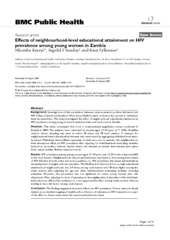| dc.contributor.author | Kayeyi, Nkomba | en_US |
| dc.contributor.author | Sandøy, Ingvild Fossgard | en_US |
| dc.contributor.author | Fylkesnes, Knut | en_US |
| dc.date.accessioned | 2013-06-18T09:27:35Z | |
| dc.date.available | 2013-06-18T09:27:35Z | |
| dc.date.issued | 2009-08-25 | eng |
| dc.Published | BMC Public Health 2009, 9:310 | eng |
| dc.identifier.issn | 1471-2458 | |
| dc.identifier.uri | https://hdl.handle.net/1956/6706 | |
| dc.description.abstract | Background: Investigations of the association between socio-economic position indicators and HIV in East, Central and Southern Africa have chiefly focused on factors that pertain to individuallevel characteristics. This study investigated the effect of neighbourhood educational attainment on HIV prevalence among young women in selected urban and rural areas in Zambia. Methods: This study re-analysed data from a cross-sectional population survey conducted in Zambia in 2003. The analyses were restricted to women aged 15–24 years (n = 1295). Stratified random cluster sampling was used to select 10 urban and 10 rural clusters. A measure for neighbourhood-level educational attainment was constructed by aggregating individual-level yearsin- school. Multi-level mixed effects regression models were run to examine the neighbourhoodlevel educational effect on HIV prevalence after adjusting for individual-level underlying variables (education, currently a student, marital status) and selected proximate determinants (ever given birth, sexual activity, lifetime sexual partners). Results: HIV prevalence among young women aged 15–24 years was 12.5% in the urban and 6.8% in the rural clusters. Neighbourhood educational attainment was found to be a strong determinant of HIV infection in both urban and rural population, i.e. HIV prevalence decreased substantially by increasing level of neighbourhood education. The likelihood of infection in low vs. high educational attainment of neighbourhoods was 3.4 times among rural women and 1.8 times higher among the urban women after adjusting for age and other individual-level underlying variables, including education. However, the association was not significant for urban young women after this adjustment. After adjusting for level of education in the neighbourhood, the effect of the individuallevel education differed by residence, i.e. a strong protective effect among urban women whereas tending to be a risk factor among rural women. Conclusion: The findings suggested structural effects on HIV prevalence. Future research should include more detailed mapping of neighbourhood factors of relevance to HIV transmission as part of the effort to better understand the causal mechanisms involved. | en_US |
| dc.language.iso | eng | eng |
| dc.publisher | BioMed Central | eng |
| dc.relation.ispartof | <a href="http://hdl.handle.net/1956/6707" target="blank">Trends in HIV Prevalence and Sexual Behaviour among Young People in Zambia</a> | eng |
| dc.rights | Attribution CC BY | eng |
| dc.rights.uri | http://creativecommons.org/licenses/by/2.5/ | eng |
| dc.title | Effects of neighbourhood-level educational attainment on HIV prevalence among young women in Zambia | en_US |
| dc.type | Peer reviewed | |
| dc.type | Journal article | |
| dc.description.version | publishedVersion | en_US |
| dc.rights.holder | Copyright 2009 Kayeyi et al; licensee BioMed Central Ltd. | |
| dc.identifier.doi | https://doi.org/10.1186/1471-2458-9-310 | |
| dc.identifier.cristin | 350435 | |
| dc.source.journal | BMC Public Health | |

